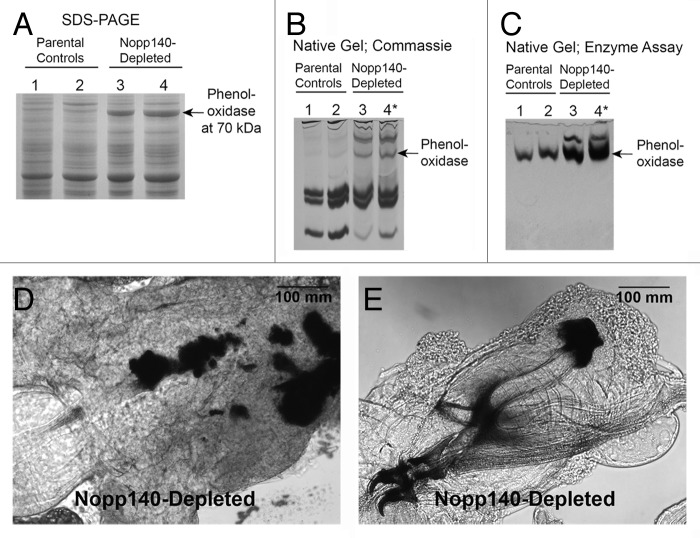Figure 6. Phenoloxidase A3 accumulated in Nopp140-depleted larvae. (A) Whole larval lysates from parental control larvae (Act5C-GAL4/CyO, lane 1; homozygous UAS-C4.2, lane 2) were compared with those from Nopp140-depleted larvae (UAS-C4.2/Act5C-GAL4, lane 3; UAS-C4/Act5C-GAL4, lane 4). UAS-C4 is the original stock containing UAS-C4.2 on the 2nd chromosome and UAS-C3 on the 3rd chromosome. The prominent 70 kDa protein in the lysates of Nopp140-depleted larvae (arrow) was identified by LC-MS/MS as phenoloxidase A3. (B) Hemolymph proteins were resolved on a native polyacrylamide gel and stained with Coomassie Blue. Parental control larvae were homozygous UAS-C4.2 (lane 1) and Act5C/CyO-GAL4 (lane 2). Nopp140-RNAi-expressing UAS-C4.2/Act5C-GAL4 larvae (lane 3) with only a few melanotic masses were compared with similar UAS-C4.2/Act5C-GAL4* larvae (lane 4) that had excess melanotic masses. (C) A native gel similar to that shown in panel B but stained for phenoloxidase activity using tyrosine as substrate. Arrows in B and C mark the position of the most prominent phenoloxidase activity. (D) Melanotic masses were found mostly in the midgut of Act5C > UAS-C4.2 larvae. (E) Melanotic masses also occurred at other sites within Act5C > UAS-C4.2 larvae. This large mass accumulated at the tips of the dorsal arms of the pharyngeal sclerite.

An official website of the United States government
Here's how you know
Official websites use .gov
A
.gov website belongs to an official
government organization in the United States.
Secure .gov websites use HTTPS
A lock (
) or https:// means you've safely
connected to the .gov website. Share sensitive
information only on official, secure websites.
